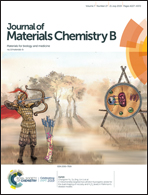The regenerated silk fibroin hydrogel with designed architecture bioprinted by its microhydrogel†
Abstract
Bioprinting technology has received wide attention in recent years, while silk fibroin has also attracted attention as a promising biomaterial with excellent comprehensive mechanical properties and biocompatibility. However, due to its non-molten state feature and the difficulty in curing its aqueous solution, the silk fibroin-based materials such as scaffolds and hydrogels with designed shapes and morphologies have hardly been fabricated via the bioprinting process. To solve this problem, a two-step procedure was employed in this work. First, the microhydrogel of the regenerated silk fibroin (RSF) with a small amount of hydroxypropyl methylcellulose (HPMC) was prepared by heating the mixture of RSF and HPMC aqueous solutions. Second, the microhydrogel was directly printed to the pre-set architecture using a bioprinter as it was not only self-standing but also displayed remarkable thixotropic property originating from “the second network”. After the bioprinted microhydrogel was ripened in ethanol to improve the β-sheet domain that physically crosslinked the network, the RSF hydrogel presented significant mechanical properties, which could be adjusted by the initial concentration of the RSF aqueous solution. Like other RSF materials produced by various ways, this 3D-printed RSF hydrogel demonstrated good cytocompatibility for hMSCs. Therefore, it may have great potential for applications in the replacement of tissues with complex structures.



 Please wait while we load your content...
Please wait while we load your content...